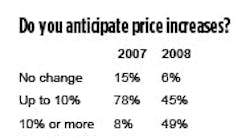Despite an uncertain economy, food and allied product executives remain cautiously optimistic about their growth prospects, according to the Food and Allied Products Industry Report, an annual survey taken this spring of 86 food executives from 82 mostly small to mid-sized companies. The primary difference this year is the degree of optimism expressed shifting from “very” optimistic to “somewhat” optimistic.“Many food and allied product companies have continued their strong performance, despite rising prices, an uncertain economy and decreased consumer spending,” says Terry Schwartz, managing director of Minneapolis-based RSM McGladrey an accounting, tax and business consulting firm who produced the survey in conjunction with is 2008 RSM McGladrey Manufacturing and Wholesale Distribution National Survey. “By taking several proactive measures, the industry, as a whole, has continued to maintain or improve gross margins. [If] the U.S. economy begins to stabilize, the future is bright for many of these companies.”
While a lot in the economic picture has changed since the survey was taken, it asked about critical industry issues -- cost structure, profitability, technology initiatives, operations and globalization. The majority (60 percent) of companies responding reported a margin of 20 percent or more, a slight gain over the 2007 survey. Commodity pricing (60 percent), selling pricing (55 percent) and internal cost-cutting measures (35 percent) were listed as the three most utilized practices that have contributed to an increase in margins while many other industries face more significant struggles.Steep increases in the cost of energy, freight and raw materials, however, are forcing food companies to raise product prices – 49 percent report increases of 10 percent or more, up from 8 percent last year. In turn, consumers are adjusting their purchasing habits, which will slow the ability of companies to pass these costs on and may lead, once again, to tightening margins.Inflation in many costs related to energy and logistics are causing executives to explore a wide variety of
strategies to maintain profits and grow business. Rising prices are forecasted in several areas, with most executives surveyed projecting an increase of 6 percent to 10 percent in the costs of energy, logistics and raw materials.To combat increasing costs, many companies are raising consumer prices. While this tactic is not necessarily a surprise, the level of price escalation is notable. Forty-five percent of food executives plan on raising their prices up to 10 percent, while 49 percent of companies surveyed said they will raise prices by 10 percent or more, a spike from just 8 percent in last year’s survey.“The escalating prices that companies have to incur is gaining a great amount of media coverage, therefore the industry is avoiding a backlash that normally would accompany a high rate of consumer price increases,” says Schwartz.More than 70 percent of respondents say their primary growth strategy is to increase sales to both new and existing domestic customers. Though not as high on the list, brand recognition as a growth strategy moved up in importance (52 percent versus 44 percent in 2007). But merger and acquisition activity slowed, reflecting current financial markets and tightening credit.
Embracing and diversifying global business is one strategy the industry may not be taking full advantage of, according to the survey. Whether exporting products, importing supplies or moving production or services offshore, moving into the global economy can cut costs and open new doors for potential business.However, only 27 of the companies surveyed “agreed” or “strongly agreed” that working globally was a part of their business strategy. Fifty-nine percent report that they are importing supplies, while 44 are exporting products for sale, but the extent of importing and exporting was not disclosed. Green initiatives appear to be gaining momentum. As the market drives the green movement, an opportunity to produce and market food products as “green” is also an opportunity to increase revenues.While the coming year poses serious challenges, it appears the industry remains in a position to weather the current economic storm. Should the economy take a deeper plunge, strategic planning and allocation of resources can go a long way toward preparing for the upturn.


